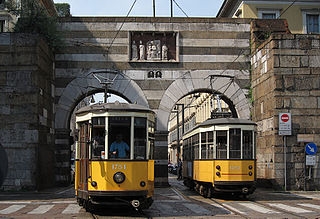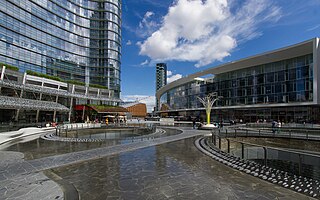
Milan is a city in northern Italy, regional capital of Lombardy, the largest city in Italy by urban population and the second-most-populous city proper in Italy after Rome. The city proper has a population of about 1.4 million, while its metropolitan city has 3.22 million residents. The urban area of Milan is the fourth-most-populous in the EU with 6.17 million inhabitants. According to national sources, the population within the wider Milan metropolitan area is estimated between 7.5 million and 8.2 million, making it by far the largest metropolitan area in Italy and one of the largest in the EU. Milan is the economic capital of Italy, one of the economic capitals of Europe and a global financial centre.

The University of Milan, officially abbreviated as UNIMI, or colloquially referred to as La Statale, is a public research university in Milan, Italy. It is one of the largest universities in Europe, with about 60,000 students, and a permanent teaching and research staff of about 2,000.

The Peter MacCallum Cancer Centre, also known as the Peter MacCallum Cancer Institute and commonly abbreviated as Peter Mac, is an Australian oncology research institute, cancer treatment and professional oncologist training centre located in Melbourne, Victoria. The centre is named in honour of Sir Peter MacCallum. Since June 2016, the centre has been located within the Victorian Comprehensive Cancer Centre (VCCC) in Parkville.
Università Cattolica del Sacro Cuore, colloquially the Catholic University of Milan or simply the Cattolica, is an Italian private research university founded in 1921. Its main campus is located in Milan, Italy, with satellite campuses in Brescia, Piacenza, Cremona and Rome.

The University of Insubria is an Italian university located in Como and Varese, with secondary locations in Busto Arsizio and Saronno. It was founded in 1998, it has been named after the area where it is situated, the historical-geographical region of Insubria.

The Policlinico of Milan, also known as Ospedale Maggiore di Milano or Ca' Granda Ospedale Maggiore Policlinico, is the public district general hospital in Milan. It is one of the oldest hospitals in Italy, founded by Francesco I Sforza, Duke of Milan, in 1456. Today it is a modern hospital with 900 beds, with wards for adults, pregnant women and children. During the first COVID-19 breakout in March 2020, 300 of those beds were readapted for COVID-19 patients.

The Sant’Orsola-Malpighi Polyclinic is a public research hospital and district general hospital in Bologna. Sant’Orsola-Malpighi Polyclinc is the largest district general hospital in Italy, and the first of the four public hospitals of the city of Bologna.

Barona is a border district ("quartiere") of the city of Milan, Italy. It is part of the Zone 6 administrative division, and it is located south of the city centre. Its population can be roughly estimated to 85,000. It borders on the comunes of Buccinasco, Assago, and Corsico and the districts of Lorenteggio and Torretta. Its boundaries are marked by the Parco Agricolo Sud Milano nature reserve to the south, by the Naviglio Grande and Naviglio Pavese canals to the east and to the west, and by the Circonvallazione ring road to the north.

Baggio is a district (quartiere) of Milan, Italy, part of the Zone 7 administrative division of the city. Before being annexed to Milan in 1923, it was an autonomous comune.
Bicocca is a district ("quartiere") of Milan, Italy, part of the Zone 9 administrative division. It was incorporated in the city in 1841. The main historic landmark of the district is the 15th century Villa Arcimboldi. In the last decades of the 20th century, the district has been subject to a major requalification project that led to the construction of important facilities such as the University of Milan Bicocca seats and the Teatro degli Arcimboldi theatre.
Niguarda is a district (quartiere) of Milan, Italy. It is an area located within Zone 9 of the city. It was an independent village until 1923, then became part of the city after the Giunta Mangiagalli (1917).

The University of Milano-Bicocca is a public university located in Milan, Italy, providing undergraduate, graduate and post-graduate education. Established in 1998, it was ranked by the Times Higher Education 2014 ranking of the best 100 Universities under 50 years old as number 21 worldwide and first in Italy.

The Milan tramway network is part of the public transport network of Milan, Italy, operated by Azienda Trasporti Milanesi (ATM).

The Zone 9 of Milan, since 2016 officially Municipality 9 of Milan, is one of the 9 administrative divisions of Milan, Italy.

The Metropolitan City of Milan is a metropolitan city in the Lombardy region of Italy. It is the second most populous metropolitan city in the nation after the Metropolitan City of Rome Capital. Its capital is the city of Milan. It replaced the province of Milan and includes the city of Milan and 132 other comuni. It was first created by the reform of local authorities and then established by the Law 56/2014. It has been operative since 1 January 2015.

Humanitas University, also recognized as Hunimed, is an Italian international private university dedicated to medical and biomedical sciences. Located within the municipality of Pieve Emanuele, a constituent of the Metropolitan City of Milan, the university's campus seamlessly integrates with the expansive Humanitas Research Hospital Campus.

The International Medical School (IMS) of the faculty of medicine of the University of Milan is a public English-language medical school located primarily in Milan and neighboring Segrate, Italy, with other teaching clinics in the Milan metropolitan area. The school is officially recognized on the United Nations World Directory of Medical Schools. It is consistently ranked as one of the top 100 medical schools in the world. Its mission is to "provide graduates with both a solid, up-to-date scientific understanding of medicine, and a deep appreciation of the human and social complexities associated with health and disease.”

The following outline is provided as an overview of and topical guide to Milan:
Milano Innovation District (MIND) is the name given to the project dedicated to the area where Expo 2015 took place in Milan.
















